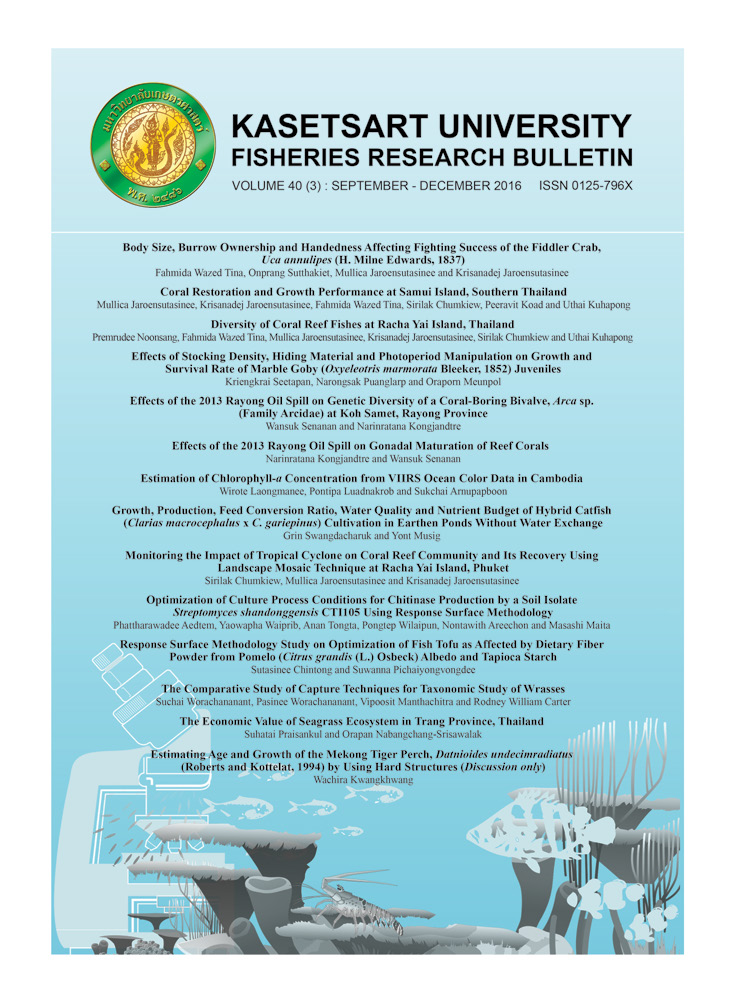Optimization of Culture Process Conditions for Chitinase Production by a Soil Isolate Streptomyces shandonggensis CTI105 Using Response Surface Methodology
Main Article Content
Abstract
Response surface methodology was used to optimize culture process conditions for chitinase production by Streptomyces shandonggensis CTI105. Firstly, a chitinase producing microorganism was screened and isolated from soft shell crab molted shell-enriched top soil from a nearby soft shell crab farming area in Chanthaburi province, Thailand. The most potent isolate, with the CZ/CS ratio of 2.08±0.14 at 7 days of incubation time at 35oC, was identified as Streptomyces shandonggensis based on 16S rRNA gene sequence analysis. Secondly, the three important culture process parameters including colloidal chitin concentration (0.5-2.5%), culture pH (4-8), and culture temperature (25–45°C) were optimized to obtain the maximum response of chitinase activity using the statistical Box-Behnken design. The quadratic polynomial equation model developed incorporates three linear, three quadratic, and one interaction term (colloidal chitin concentration and pH). The predicted chitinase production obtained from the quadratic polynomial model using the optimum conditions of colloidal chitin concentration, pH and temperature (1.53% w/v, 6.06 and 34.89oC respectively) was 36.39 Unit ml-1. The result demonstrated that Box-Behnken design response surface methodology was an effective way to obtain optimal conditions for chitinase production by Streptomyces shandonggensis.
Article Details
References
2. Beier, S. and S. Bertilsson. 2013. Bacterial chitin degradation-mechanisms and ecophysiological strategies. Frontiers in Microbiology. 4(149): 1-12.
3. Brzezinska, M.S., U. Jankiewicz and M. Walczak. 2013. Biodegradation of chitinous substances and chitinase production by the soil Actinomycete Streptomyces rimosus. International Biodeterioration & Biodegradation. 84: 104-110.
4. Faramarzi, M.A., M. Fazeli, M. Tabatabaei Yazdi, S.Adrangi, K. Jami Al Ahmadi, N. Tasharrofi and F. Aziz Mohseni. 2009. Optimization of cultural conditions for production of chitinase by a soil isolate of Massilia timonae. Biotechnology. 8: 93-99.
5. Gooday, G.W. 1990. The ecology of chitin degradation. Advances in Microbial Ecology. 11: 387-430.
6. Hamid, R., M.A. Khan, M. Ahmad, M.M. Ahmad, M.Z. Abdin, J. Musarrat and S. Javed. 2013. chitinases: An update. Journal of Pharmacy And Bioallied Sciences. 5(1): 21-29.
7. Hoang, K.C., T.H. Lai, C.S. Lin, Y.T. Chen and C.Y. Liau. 2010. The chitinolytic activities of Streptomyces sp. Th-11. International Journal of Molecular Sciences. 12(1): 56-65.
8. Joo, GJ. 2005. Purification and characterization of an extracellular chitinase from the antifungal biocontrol agent Streptomyces halstedii. Biotechnology Letters. 27(19): 1483-1486.
9. Kuddns, S.M. and R.I.Z. Ahmad. 2013. Isolation of novel chitinolytic bacteria and production optimization of extracellular chitinase. Journal of Genetic Engineering and Biotechnology. 11:39-46.
10. Kumanm, S., B. Deivasigamani, U. Vairagkar, S. Balamurugan and M. Sakthivel. 2012. Evaluation of chitinase producing and antimicrobial properties of Streptomyces isolated from shrimp shell disposable area. Asian Pacific Journal of Tropical Disease. 2: 861-864.
11. Meruvu, H. and S.R.R. Donthireddy. 2014. Optimization studies for chitinase production from Parapeneopsis hardwickii (Spear Shrimp) exoskeleton by solid-state fermentation with marine isolate Citrobacter freundii Str. Nov. Haritd11. Arabian Journal for Science and Engineering. 39(7): 5297-5306.
12. Momeal, J. and E.T. Reese. 1969. The chitinase of Serratia marcescens. Canadian Journal of Microbiology. 15(7): 689-696.
13. Narayana, K.J.P. and M. Vijayalaksbmi. 2009. Chitinase production by Streptomyces sp. ANU6277. Brazilian Journal of Microbiology.40: 725-733.
14. Pradeep, G.C., Y.H. Choi, Y.S. Choi, S.E. Suh, J.H. Seong, S.S. Cho, M.-S. Bae and J.C. Yoo. 2014. An extremely alkaline novel chitinase from Streptomyces sp. CS495. Process Biochemistry. 49(2): 223-229.
15. Rathore, A.S. and R.D. Gupta. 2015. Chitinases from bacteria to human: Properties, applications, and future perspectives. Enzyme Research. 1: 1-8.
16. Reissig, J.L., J.L. Strominger and L.F. Leloir. 1955. A modified colorimetric method for the estimation of N-acetylamino sugars. The Journal of Biological Chemistry.217: 959-966.
17. Souza, C., E.M. Burbano-Rosero, B. Almeida, G. Martins, L. Albertini and I.G. Rivera. 2009. Culture medium for isolating chitinolytic bacteria from seawater and plankton. World Journal of Microbiology and Biotechnology. 25(11): 2079-2082.
18. Sudhakar, P. and P. Nagarajan. 2011.Optimization of chitinase production using statistics based experimental designs. Journal of Chemical, Biological and Physical Sciences. 1: 352-362.
19. Taechowisan, T., J.F. Peberdy and S. Lumyong. 2003. Chitinase production by endophytic Streptomyces Aureofaciens CMUAc130 and its antagonism against phytopathogenic fungi. Annals of Microbiology. 53: 447-461.
20. Tasharrofi, N., S. Adrangie, M. Fazeli, H. Rastegar, M.R. K.hoshayand and M.A. Faramarzi. 2011. Optimization of chitinase production by Bacillus pumilususing Plackett-Burman Design and response surface methodology. Iranian Journal of Pharmaceutical Research. 10: 759-768.
21. Vaidya, R.J., I.M. Shah, P.R. Vyas and H.S. Chhatpar. 2001. Production of chitinase and its optimization from a novel isolate Alcaligenes xylosoxydan: Potential in antifungal biocontrol. World Journal of Microbiology and Biotechnology. 17: 691-696.
22. Wang, K., P.S. Yan and L.X. Cao. 2014. Chitinase from a novel strain of Serratia marcescens Jpp1 for biocontrol of Aflatoxin: Molecular characterization and production optimization using response surface methodology. BioMed Research International. 1: 1-8.
23. Yandigeri, M.S., N. Malviya, M.K. Solanki, P. Shrivastava and G. Sivakumar. 2015. Chitinolytic Streptomyces vinaceusdrappus S5MW2 isolated from Chilika Lake, India enhances plant growth and biocontrol efficacy through chitin supplementation gainst Rhizoctonia solani. World Journal of Microbiology and Biotechnology. 31(8): 1217-1225.-36.

